Analysis of Online Spatial Delivery System Report for DSI
VerifiedAdded on 2022/09/14
|9
|2143
|11
Report
AI Summary
This report provides a comprehensive overview of the Online Spatial Delivery System (OSDS), an online application designed for delivering spatial information. It begins by introducing the system and its cloud-based architecture, emphasizing the use of cloud computing. The report then delves into the advantages and disadvantages of using Infrastructure as a Service (IaaS) and Platform as a Service (PaaS) approaches, highlighting cost savings, ease of maintenance, and scalability. It also explores the architectural design of the OSDS, advocating for a collection of services integrated through APIs and considering communication, scaling, and security. Furthermore, the report discusses the benefits of cloud edge solutions for OSDS, including high performance and accessibility, while also addressing potential drawbacks like security risks and data loss. Finally, it compares monolithic and microservices architectures, recommending a microservices approach for OSDS implementation due to its ease of onboarding, reduced risks, flexible data storage, and support for polyglot programming. The report concludes by summarizing the key findings and emphasizing the suitability of microservices architecture for the OSDS application.
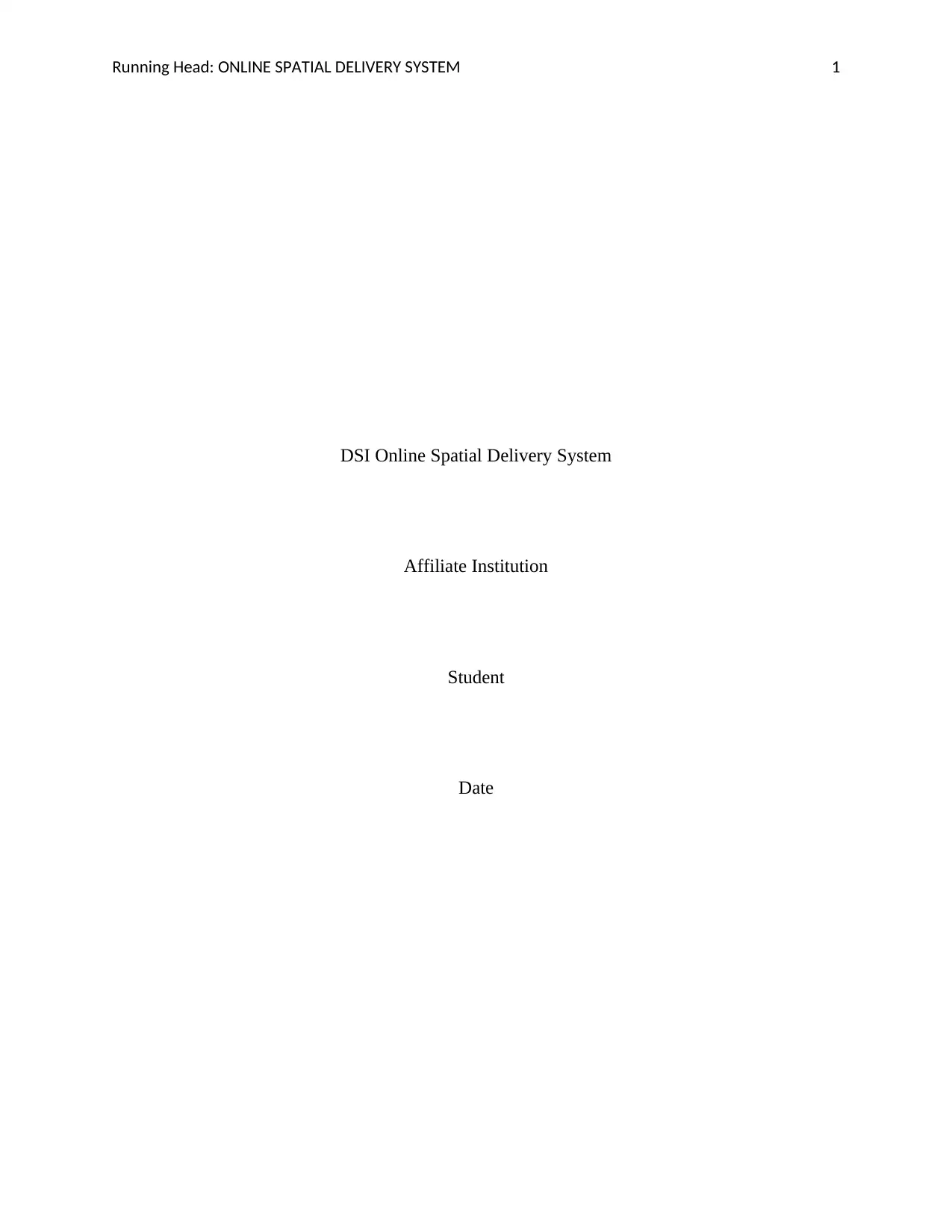
Running Head: ONLINE SPATIAL DELIVERY SYSTEM 1
DSI Online Spatial Delivery System
Affiliate Institution
Student
Date
DSI Online Spatial Delivery System
Affiliate Institution
Student
Date
Paraphrase This Document
Need a fresh take? Get an instant paraphrase of this document with our AI Paraphraser
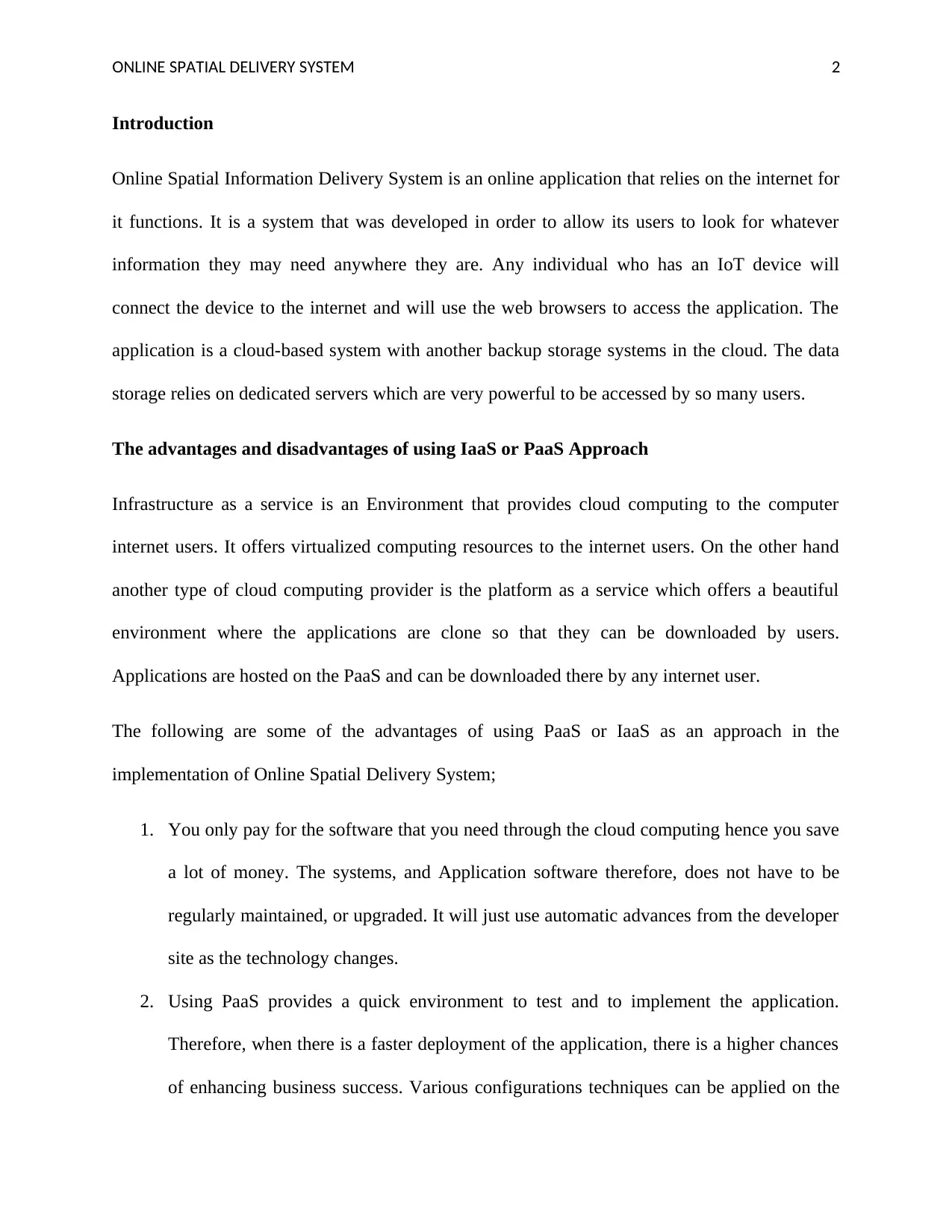
ONLINE SPATIAL DELIVERY SYSTEM 2
Introduction
Online Spatial Information Delivery System is an online application that relies on the internet for
it functions. It is a system that was developed in order to allow its users to look for whatever
information they may need anywhere they are. Any individual who has an IoT device will
connect the device to the internet and will use the web browsers to access the application. The
application is a cloud-based system with another backup storage systems in the cloud. The data
storage relies on dedicated servers which are very powerful to be accessed by so many users.
The advantages and disadvantages of using IaaS or PaaS Approach
Infrastructure as a service is an Environment that provides cloud computing to the computer
internet users. It offers virtualized computing resources to the internet users. On the other hand
another type of cloud computing provider is the platform as a service which offers a beautiful
environment where the applications are clone so that they can be downloaded by users.
Applications are hosted on the PaaS and can be downloaded there by any internet user.
The following are some of the advantages of using PaaS or IaaS as an approach in the
implementation of Online Spatial Delivery System;
1. You only pay for the software that you need through the cloud computing hence you save
a lot of money. The systems, and Application software therefore, does not have to be
regularly maintained, or upgraded. It will just use automatic advances from the developer
site as the technology changes.
2. Using PaaS provides a quick environment to test and to implement the application.
Therefore, when there is a faster deployment of the application, there is a higher chances
of enhancing business success. Various configurations techniques can be applied on the
Introduction
Online Spatial Information Delivery System is an online application that relies on the internet for
it functions. It is a system that was developed in order to allow its users to look for whatever
information they may need anywhere they are. Any individual who has an IoT device will
connect the device to the internet and will use the web browsers to access the application. The
application is a cloud-based system with another backup storage systems in the cloud. The data
storage relies on dedicated servers which are very powerful to be accessed by so many users.
The advantages and disadvantages of using IaaS or PaaS Approach
Infrastructure as a service is an Environment that provides cloud computing to the computer
internet users. It offers virtualized computing resources to the internet users. On the other hand
another type of cloud computing provider is the platform as a service which offers a beautiful
environment where the applications are clone so that they can be downloaded by users.
Applications are hosted on the PaaS and can be downloaded there by any internet user.
The following are some of the advantages of using PaaS or IaaS as an approach in the
implementation of Online Spatial Delivery System;
1. You only pay for the software that you need through the cloud computing hence you save
a lot of money. The systems, and Application software therefore, does not have to be
regularly maintained, or upgraded. It will just use automatic advances from the developer
site as the technology changes.
2. Using PaaS provides a quick environment to test and to implement the application.
Therefore, when there is a faster deployment of the application, there is a higher chances
of enhancing business success. Various configurations techniques can be applied on the
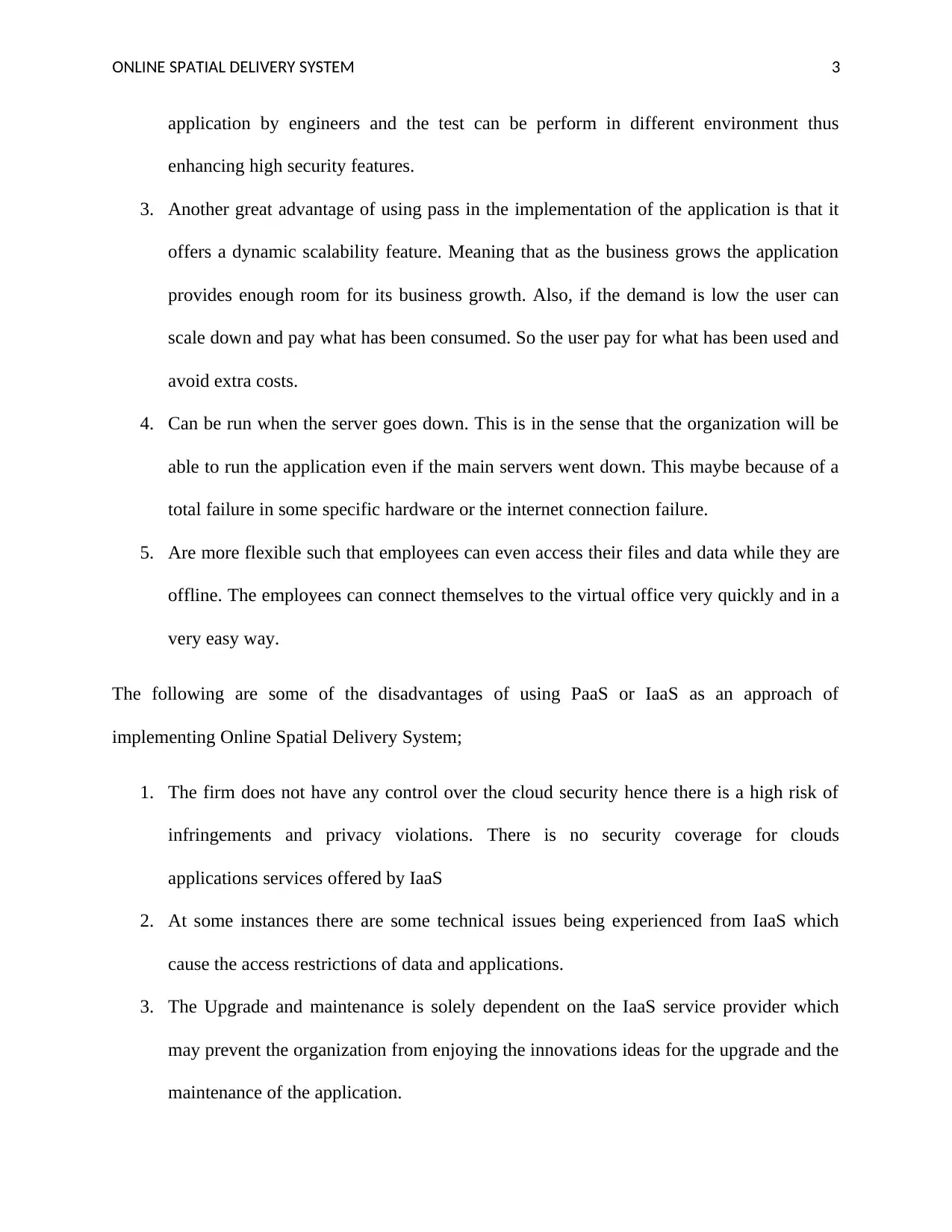
ONLINE SPATIAL DELIVERY SYSTEM 3
application by engineers and the test can be perform in different environment thus
enhancing high security features.
3. Another great advantage of using pass in the implementation of the application is that it
offers a dynamic scalability feature. Meaning that as the business grows the application
provides enough room for its business growth. Also, if the demand is low the user can
scale down and pay what has been consumed. So the user pay for what has been used and
avoid extra costs.
4. Can be run when the server goes down. This is in the sense that the organization will be
able to run the application even if the main servers went down. This maybe because of a
total failure in some specific hardware or the internet connection failure.
5. Are more flexible such that employees can even access their files and data while they are
offline. The employees can connect themselves to the virtual office very quickly and in a
very easy way.
The following are some of the disadvantages of using PaaS or IaaS as an approach of
implementing Online Spatial Delivery System;
1. The firm does not have any control over the cloud security hence there is a high risk of
infringements and privacy violations. There is no security coverage for clouds
applications services offered by IaaS
2. At some instances there are some technical issues being experienced from IaaS which
cause the access restrictions of data and applications.
3. The Upgrade and maintenance is solely dependent on the IaaS service provider which
may prevent the organization from enjoying the innovations ideas for the upgrade and the
maintenance of the application.
application by engineers and the test can be perform in different environment thus
enhancing high security features.
3. Another great advantage of using pass in the implementation of the application is that it
offers a dynamic scalability feature. Meaning that as the business grows the application
provides enough room for its business growth. Also, if the demand is low the user can
scale down and pay what has been consumed. So the user pay for what has been used and
avoid extra costs.
4. Can be run when the server goes down. This is in the sense that the organization will be
able to run the application even if the main servers went down. This maybe because of a
total failure in some specific hardware or the internet connection failure.
5. Are more flexible such that employees can even access their files and data while they are
offline. The employees can connect themselves to the virtual office very quickly and in a
very easy way.
The following are some of the disadvantages of using PaaS or IaaS as an approach of
implementing Online Spatial Delivery System;
1. The firm does not have any control over the cloud security hence there is a high risk of
infringements and privacy violations. There is no security coverage for clouds
applications services offered by IaaS
2. At some instances there are some technical issues being experienced from IaaS which
cause the access restrictions of data and applications.
3. The Upgrade and maintenance is solely dependent on the IaaS service provider which
may prevent the organization from enjoying the innovations ideas for the upgrade and the
maintenance of the application.
⊘ This is a preview!⊘
Do you want full access?
Subscribe today to unlock all pages.

Trusted by 1+ million students worldwide
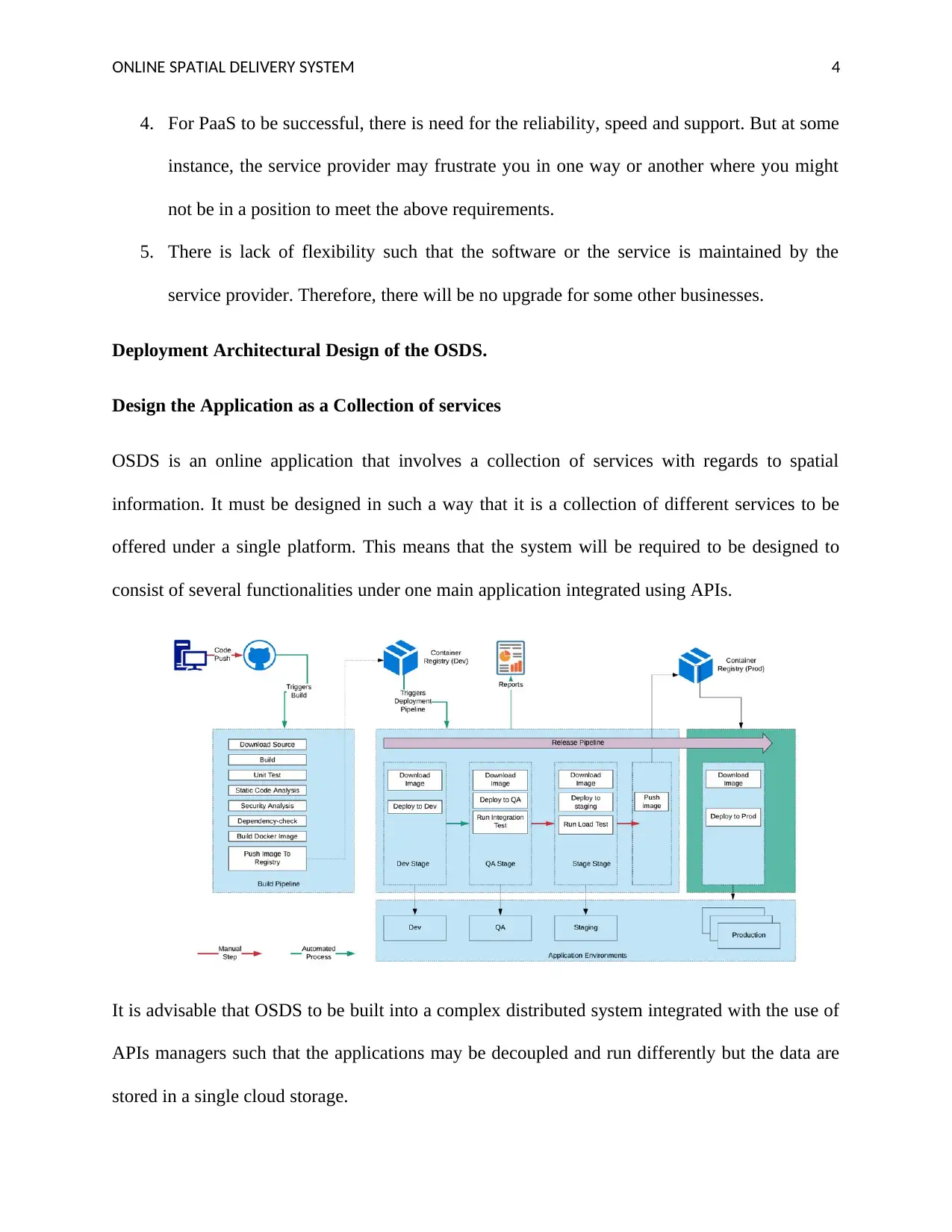
ONLINE SPATIAL DELIVERY SYSTEM 4
4. For PaaS to be successful, there is need for the reliability, speed and support. But at some
instance, the service provider may frustrate you in one way or another where you might
not be in a position to meet the above requirements.
5. There is lack of flexibility such that the software or the service is maintained by the
service provider. Therefore, there will be no upgrade for some other businesses.
Deployment Architectural Design of the OSDS.
Design the Application as a Collection of services
OSDS is an online application that involves a collection of services with regards to spatial
information. It must be designed in such a way that it is a collection of different services to be
offered under a single platform. This means that the system will be required to be designed to
consist of several functionalities under one main application integrated using APIs.
It is advisable that OSDS to be built into a complex distributed system integrated with the use of
APIs managers such that the applications may be decoupled and run differently but the data are
stored in a single cloud storage.
4. For PaaS to be successful, there is need for the reliability, speed and support. But at some
instance, the service provider may frustrate you in one way or another where you might
not be in a position to meet the above requirements.
5. There is lack of flexibility such that the software or the service is maintained by the
service provider. Therefore, there will be no upgrade for some other businesses.
Deployment Architectural Design of the OSDS.
Design the Application as a Collection of services
OSDS is an online application that involves a collection of services with regards to spatial
information. It must be designed in such a way that it is a collection of different services to be
offered under a single platform. This means that the system will be required to be designed to
consist of several functionalities under one main application integrated using APIs.
It is advisable that OSDS to be built into a complex distributed system integrated with the use of
APIs managers such that the applications may be decoupled and run differently but the data are
stored in a single cloud storage.
Paraphrase This Document
Need a fresh take? Get an instant paraphrase of this document with our AI Paraphraser
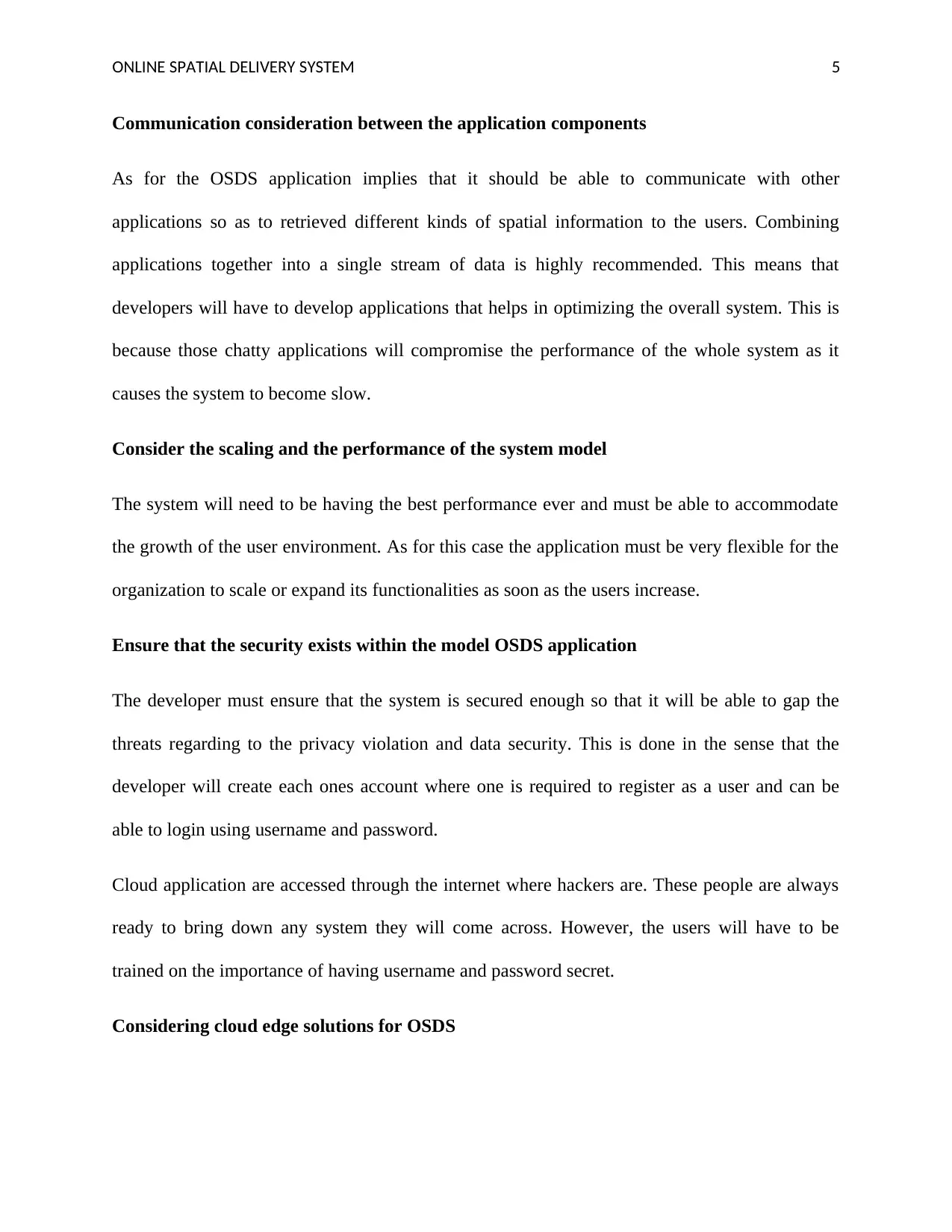
ONLINE SPATIAL DELIVERY SYSTEM 5
Communication consideration between the application components
As for the OSDS application implies that it should be able to communicate with other
applications so as to retrieved different kinds of spatial information to the users. Combining
applications together into a single stream of data is highly recommended. This means that
developers will have to develop applications that helps in optimizing the overall system. This is
because those chatty applications will compromise the performance of the whole system as it
causes the system to become slow.
Consider the scaling and the performance of the system model
The system will need to be having the best performance ever and must be able to accommodate
the growth of the user environment. As for this case the application must be very flexible for the
organization to scale or expand its functionalities as soon as the users increase.
Ensure that the security exists within the model OSDS application
The developer must ensure that the system is secured enough so that it will be able to gap the
threats regarding to the privacy violation and data security. This is done in the sense that the
developer will create each ones account where one is required to register as a user and can be
able to login using username and password.
Cloud application are accessed through the internet where hackers are. These people are always
ready to bring down any system they will come across. However, the users will have to be
trained on the importance of having username and password secret.
Considering cloud edge solutions for OSDS
Communication consideration between the application components
As for the OSDS application implies that it should be able to communicate with other
applications so as to retrieved different kinds of spatial information to the users. Combining
applications together into a single stream of data is highly recommended. This means that
developers will have to develop applications that helps in optimizing the overall system. This is
because those chatty applications will compromise the performance of the whole system as it
causes the system to become slow.
Consider the scaling and the performance of the system model
The system will need to be having the best performance ever and must be able to accommodate
the growth of the user environment. As for this case the application must be very flexible for the
organization to scale or expand its functionalities as soon as the users increase.
Ensure that the security exists within the model OSDS application
The developer must ensure that the system is secured enough so that it will be able to gap the
threats regarding to the privacy violation and data security. This is done in the sense that the
developer will create each ones account where one is required to register as a user and can be
able to login using username and password.
Cloud application are accessed through the internet where hackers are. These people are always
ready to bring down any system they will come across. However, the users will have to be
trained on the importance of having username and password secret.
Considering cloud edge solutions for OSDS
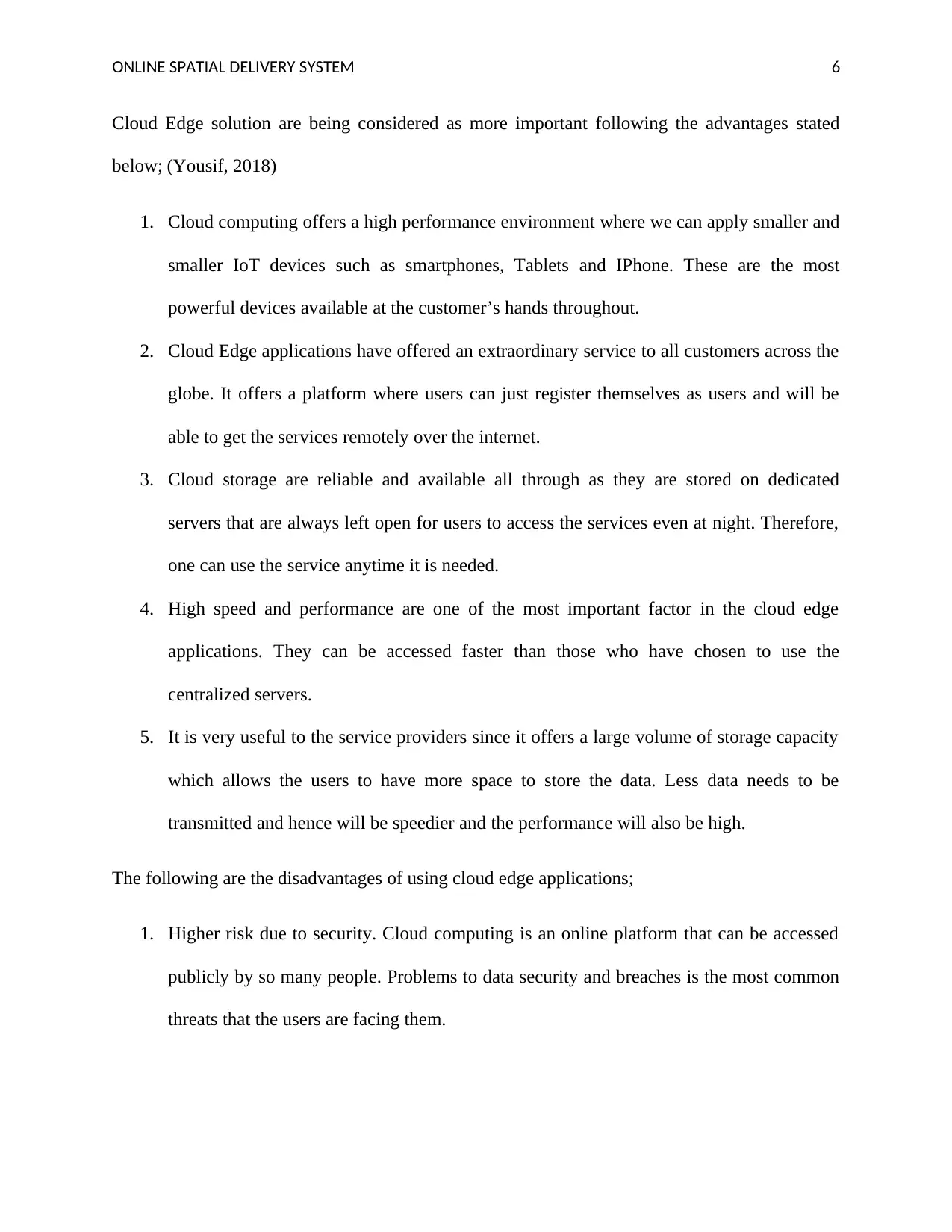
ONLINE SPATIAL DELIVERY SYSTEM 6
Cloud Edge solution are being considered as more important following the advantages stated
below; (Yousif, 2018)
1. Cloud computing offers a high performance environment where we can apply smaller and
smaller IoT devices such as smartphones, Tablets and IPhone. These are the most
powerful devices available at the customer’s hands throughout.
2. Cloud Edge applications have offered an extraordinary service to all customers across the
globe. It offers a platform where users can just register themselves as users and will be
able to get the services remotely over the internet.
3. Cloud storage are reliable and available all through as they are stored on dedicated
servers that are always left open for users to access the services even at night. Therefore,
one can use the service anytime it is needed.
4. High speed and performance are one of the most important factor in the cloud edge
applications. They can be accessed faster than those who have chosen to use the
centralized servers.
5. It is very useful to the service providers since it offers a large volume of storage capacity
which allows the users to have more space to store the data. Less data needs to be
transmitted and hence will be speedier and the performance will also be high.
The following are the disadvantages of using cloud edge applications;
1. Higher risk due to security. Cloud computing is an online platform that can be accessed
publicly by so many people. Problems to data security and breaches is the most common
threats that the users are facing them.
Cloud Edge solution are being considered as more important following the advantages stated
below; (Yousif, 2018)
1. Cloud computing offers a high performance environment where we can apply smaller and
smaller IoT devices such as smartphones, Tablets and IPhone. These are the most
powerful devices available at the customer’s hands throughout.
2. Cloud Edge applications have offered an extraordinary service to all customers across the
globe. It offers a platform where users can just register themselves as users and will be
able to get the services remotely over the internet.
3. Cloud storage are reliable and available all through as they are stored on dedicated
servers that are always left open for users to access the services even at night. Therefore,
one can use the service anytime it is needed.
4. High speed and performance are one of the most important factor in the cloud edge
applications. They can be accessed faster than those who have chosen to use the
centralized servers.
5. It is very useful to the service providers since it offers a large volume of storage capacity
which allows the users to have more space to store the data. Less data needs to be
transmitted and hence will be speedier and the performance will also be high.
The following are the disadvantages of using cloud edge applications;
1. Higher risk due to security. Cloud computing is an online platform that can be accessed
publicly by so many people. Problems to data security and breaches is the most common
threats that the users are facing them.
⊘ This is a preview!⊘
Do you want full access?
Subscribe today to unlock all pages.

Trusted by 1+ million students worldwide
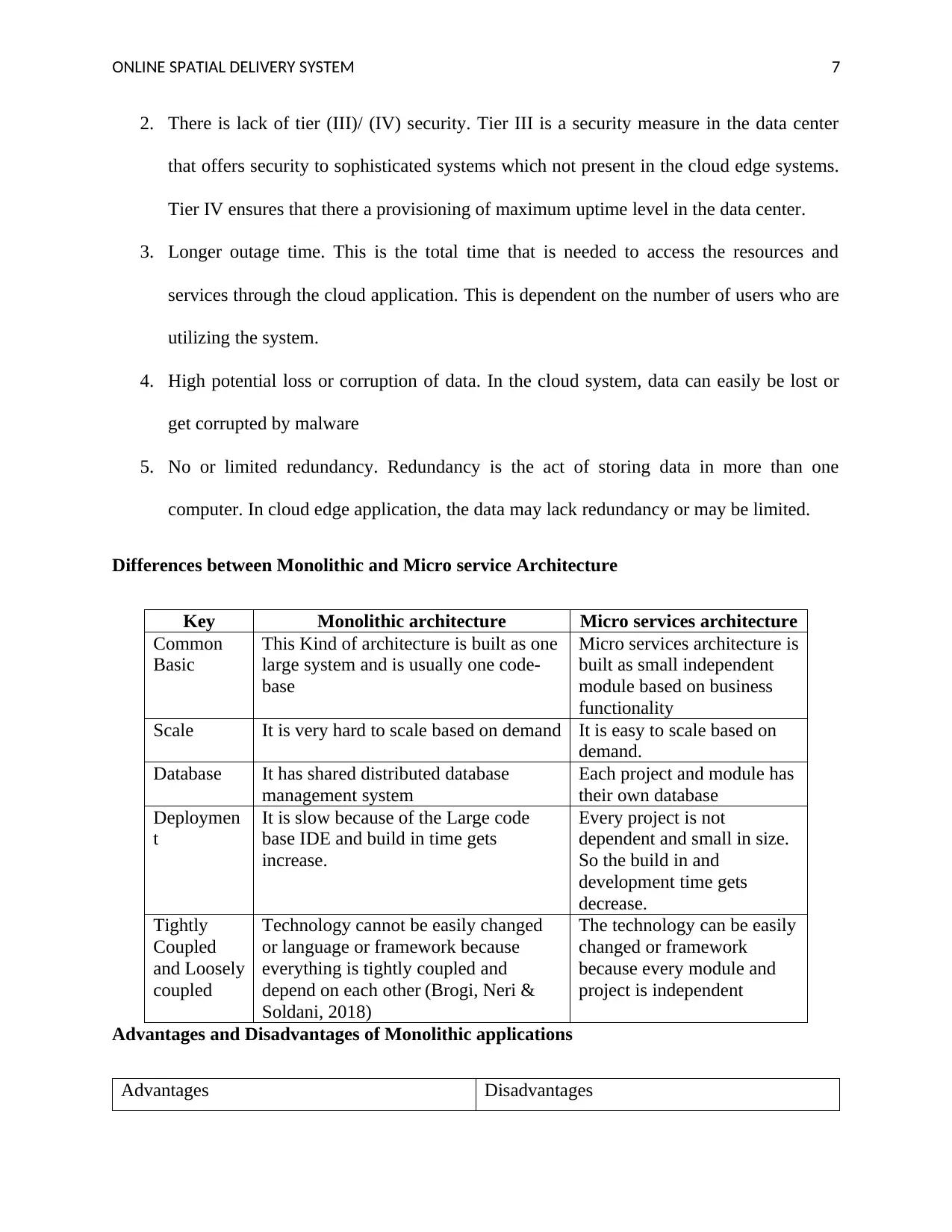
ONLINE SPATIAL DELIVERY SYSTEM 7
2. There is lack of tier (III)/ (IV) security. Tier III is a security measure in the data center
that offers security to sophisticated systems which not present in the cloud edge systems.
Tier IV ensures that there a provisioning of maximum uptime level in the data center.
3. Longer outage time. This is the total time that is needed to access the resources and
services through the cloud application. This is dependent on the number of users who are
utilizing the system.
4. High potential loss or corruption of data. In the cloud system, data can easily be lost or
get corrupted by malware
5. No or limited redundancy. Redundancy is the act of storing data in more than one
computer. In cloud edge application, the data may lack redundancy or may be limited.
Differences between Monolithic and Micro service Architecture
Key Monolithic architecture Micro services architecture
Common
Basic
This Kind of architecture is built as one
large system and is usually one code-
base
Micro services architecture is
built as small independent
module based on business
functionality
Scale It is very hard to scale based on demand It is easy to scale based on
demand.
Database It has shared distributed database
management system
Each project and module has
their own database
Deploymen
t
It is slow because of the Large code
base IDE and build in time gets
increase.
Every project is not
dependent and small in size.
So the build in and
development time gets
decrease.
Tightly
Coupled
and Loosely
coupled
Technology cannot be easily changed
or language or framework because
everything is tightly coupled and
depend on each other (Brogi, Neri &
Soldani, 2018)
The technology can be easily
changed or framework
because every module and
project is independent
Advantages and Disadvantages of Monolithic applications
Advantages Disadvantages
2. There is lack of tier (III)/ (IV) security. Tier III is a security measure in the data center
that offers security to sophisticated systems which not present in the cloud edge systems.
Tier IV ensures that there a provisioning of maximum uptime level in the data center.
3. Longer outage time. This is the total time that is needed to access the resources and
services through the cloud application. This is dependent on the number of users who are
utilizing the system.
4. High potential loss or corruption of data. In the cloud system, data can easily be lost or
get corrupted by malware
5. No or limited redundancy. Redundancy is the act of storing data in more than one
computer. In cloud edge application, the data may lack redundancy or may be limited.
Differences between Monolithic and Micro service Architecture
Key Monolithic architecture Micro services architecture
Common
Basic
This Kind of architecture is built as one
large system and is usually one code-
base
Micro services architecture is
built as small independent
module based on business
functionality
Scale It is very hard to scale based on demand It is easy to scale based on
demand.
Database It has shared distributed database
management system
Each project and module has
their own database
Deploymen
t
It is slow because of the Large code
base IDE and build in time gets
increase.
Every project is not
dependent and small in size.
So the build in and
development time gets
decrease.
Tightly
Coupled
and Loosely
coupled
Technology cannot be easily changed
or language or framework because
everything is tightly coupled and
depend on each other (Brogi, Neri &
Soldani, 2018)
The technology can be easily
changed or framework
because every module and
project is independent
Advantages and Disadvantages of Monolithic applications
Advantages Disadvantages
Paraphrase This Document
Need a fresh take? Get an instant paraphrase of this document with our AI Paraphraser
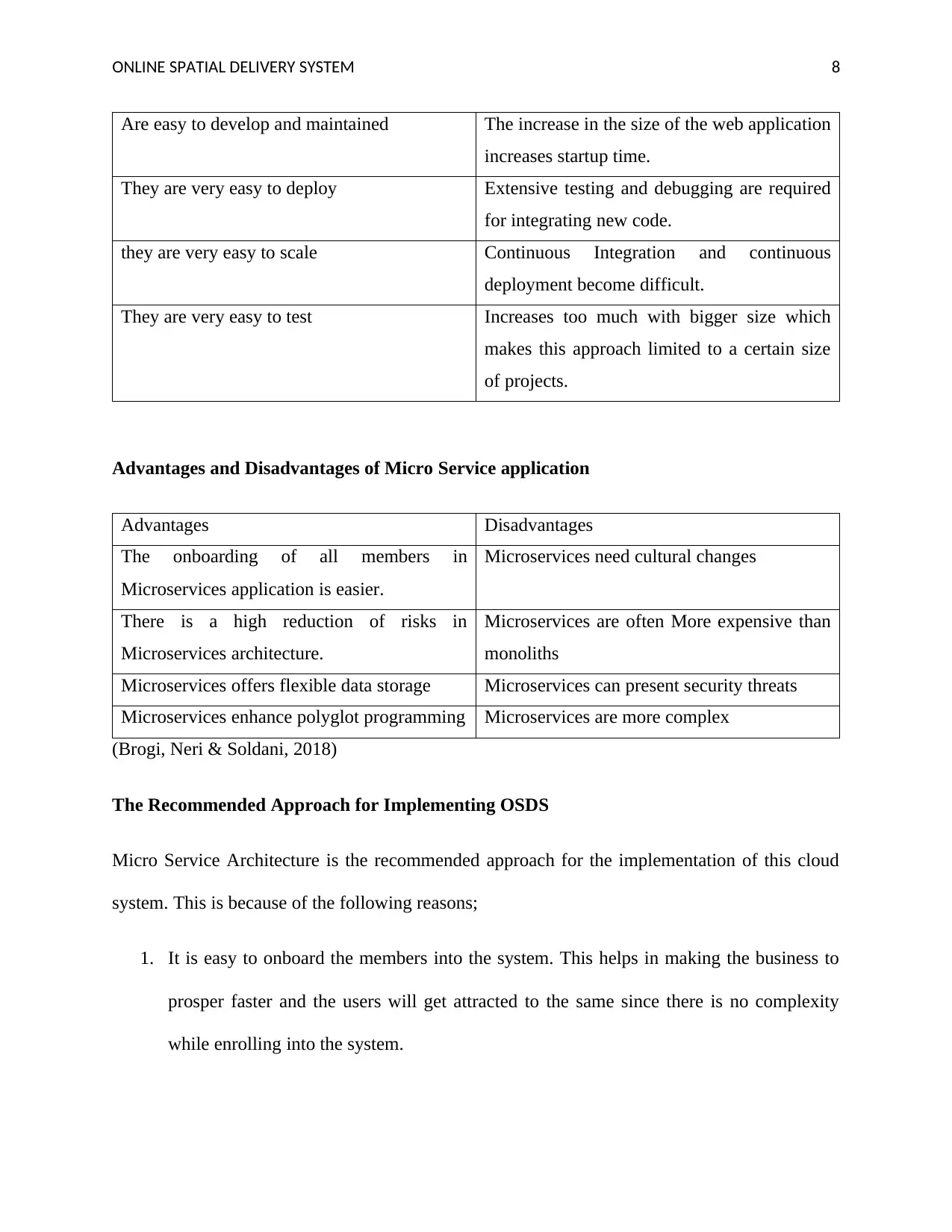
ONLINE SPATIAL DELIVERY SYSTEM 8
Are easy to develop and maintained The increase in the size of the web application
increases startup time.
They are very easy to deploy Extensive testing and debugging are required
for integrating new code.
they are very easy to scale Continuous Integration and continuous
deployment become difficult.
They are very easy to test Increases too much with bigger size which
makes this approach limited to a certain size
of projects.
Advantages and Disadvantages of Micro Service application
Advantages Disadvantages
The onboarding of all members in
Microservices application is easier.
Microservices need cultural changes
There is a high reduction of risks in
Microservices architecture.
Microservices are often More expensive than
monoliths
Microservices offers flexible data storage Microservices can present security threats
Microservices enhance polyglot programming Microservices are more complex
(Brogi, Neri & Soldani, 2018)
The Recommended Approach for Implementing OSDS
Micro Service Architecture is the recommended approach for the implementation of this cloud
system. This is because of the following reasons;
1. It is easy to onboard the members into the system. This helps in making the business to
prosper faster and the users will get attracted to the same since there is no complexity
while enrolling into the system.
Are easy to develop and maintained The increase in the size of the web application
increases startup time.
They are very easy to deploy Extensive testing and debugging are required
for integrating new code.
they are very easy to scale Continuous Integration and continuous
deployment become difficult.
They are very easy to test Increases too much with bigger size which
makes this approach limited to a certain size
of projects.
Advantages and Disadvantages of Micro Service application
Advantages Disadvantages
The onboarding of all members in
Microservices application is easier.
Microservices need cultural changes
There is a high reduction of risks in
Microservices architecture.
Microservices are often More expensive than
monoliths
Microservices offers flexible data storage Microservices can present security threats
Microservices enhance polyglot programming Microservices are more complex
(Brogi, Neri & Soldani, 2018)
The Recommended Approach for Implementing OSDS
Micro Service Architecture is the recommended approach for the implementation of this cloud
system. This is because of the following reasons;
1. It is easy to onboard the members into the system. This helps in making the business to
prosper faster and the users will get attracted to the same since there is no complexity
while enrolling into the system.
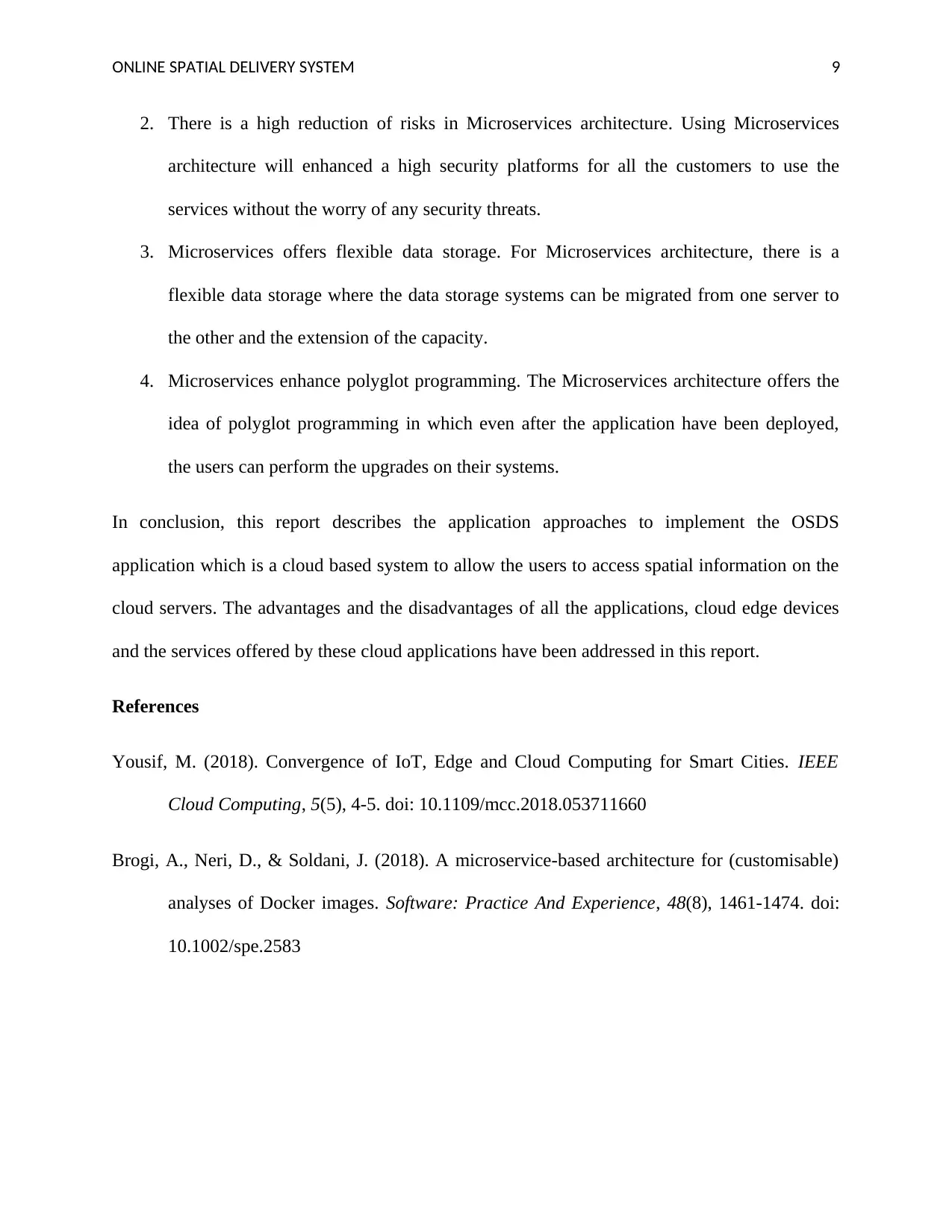
ONLINE SPATIAL DELIVERY SYSTEM 9
2. There is a high reduction of risks in Microservices architecture. Using Microservices
architecture will enhanced a high security platforms for all the customers to use the
services without the worry of any security threats.
3. Microservices offers flexible data storage. For Microservices architecture, there is a
flexible data storage where the data storage systems can be migrated from one server to
the other and the extension of the capacity.
4. Microservices enhance polyglot programming. The Microservices architecture offers the
idea of polyglot programming in which even after the application have been deployed,
the users can perform the upgrades on their systems.
In conclusion, this report describes the application approaches to implement the OSDS
application which is a cloud based system to allow the users to access spatial information on the
cloud servers. The advantages and the disadvantages of all the applications, cloud edge devices
and the services offered by these cloud applications have been addressed in this report.
References
Yousif, M. (2018). Convergence of IoT, Edge and Cloud Computing for Smart Cities. IEEE
Cloud Computing, 5(5), 4-5. doi: 10.1109/mcc.2018.053711660
Brogi, A., Neri, D., & Soldani, J. (2018). A microservice-based architecture for (customisable)
analyses of Docker images. Software: Practice And Experience, 48(8), 1461-1474. doi:
10.1002/spe.2583
2. There is a high reduction of risks in Microservices architecture. Using Microservices
architecture will enhanced a high security platforms for all the customers to use the
services without the worry of any security threats.
3. Microservices offers flexible data storage. For Microservices architecture, there is a
flexible data storage where the data storage systems can be migrated from one server to
the other and the extension of the capacity.
4. Microservices enhance polyglot programming. The Microservices architecture offers the
idea of polyglot programming in which even after the application have been deployed,
the users can perform the upgrades on their systems.
In conclusion, this report describes the application approaches to implement the OSDS
application which is a cloud based system to allow the users to access spatial information on the
cloud servers. The advantages and the disadvantages of all the applications, cloud edge devices
and the services offered by these cloud applications have been addressed in this report.
References
Yousif, M. (2018). Convergence of IoT, Edge and Cloud Computing for Smart Cities. IEEE
Cloud Computing, 5(5), 4-5. doi: 10.1109/mcc.2018.053711660
Brogi, A., Neri, D., & Soldani, J. (2018). A microservice-based architecture for (customisable)
analyses of Docker images. Software: Practice And Experience, 48(8), 1461-1474. doi:
10.1002/spe.2583
⊘ This is a preview!⊘
Do you want full access?
Subscribe today to unlock all pages.

Trusted by 1+ million students worldwide
1 out of 9
Related Documents
Your All-in-One AI-Powered Toolkit for Academic Success.
+13062052269
info@desklib.com
Available 24*7 on WhatsApp / Email
![[object Object]](/_next/static/media/star-bottom.7253800d.svg)
Unlock your academic potential
Copyright © 2020–2025 A2Z Services. All Rights Reserved. Developed and managed by ZUCOL.


